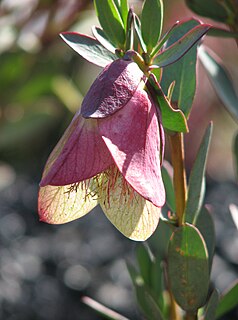
Pimelea physodes, commonly known as Qualup bell, is a species of shrub that is endemic to Western Australia. It has egg-shaped to narrow elliptical leaves and distinctive bell-like inflorescences with tiny greenish flowers surrounded by long elliptical bracts. The inflorescence resembles those of some of the only distantly-related darwinia "bells" and the bracts are a combination of red, purple, green and cream-coloured.
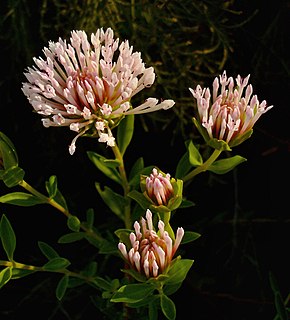
Pimelea calcicola is a species of flowering plant in the family Thymelaeaceae and is endemic to part of the west coast of Western Australia. It is an erect to spreading shrub with elliptic leaves arranged in opposite pairs, and head-like racemes of pale to deep pink, tube-shaped flowers surrounded by leaf-like involucral bracts.

Pimelea ferruginea, commonly known as pink rice flower or coastal banjine, is a species of flowering plant in the family Thymelaeaceae and is endemic to near-coastal areas of south-western Western Australia. It is a dense, erect shrub with elliptic to narrowly elliptic leaves and head-like clusters of pale to deep pink, tube-shaped flowers.
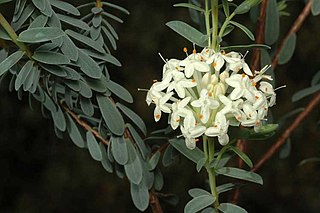
Pimelea ciliolaris is a species of flowering plant in the family Thymelaeaceae and is endemic to a restricted area of New South Wales. It is a stunted shrub with narrowly elliptic leaves and heads of densely hairy, cream-coloured to pale yellow flowers.
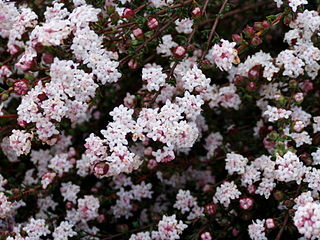
Pimelea brachyphylla is a species of flowering plant in the family Thymelaeaceae and is endemic to the south-west of Western Australia. It is an erect to spreading shrub with linear to elliptic leaves and clusters of white, tube-shaped flowers.

Petrophile antecedens is a species of flowering plant in the family Proteaceae and is endemic to southwestern Western Australia. It is a small, erect, open shrub with sharply-pointed, cylindrical leaves and spherical heads of hairy, pale cream-coloured flowers.
Petrophile clavata is a species of flowering plant in the family Proteaceae and is endemic to southwestern Western Australia. It is a shrub with curved, needle-shaped, sharply-pointed leaves and spherical heads of hairy, cream-coloured to very pale yellow flowers.
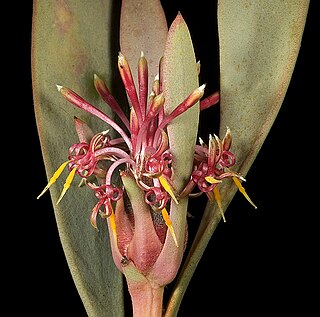
Isopogon pruinosus is a species of flowering plant in the family Proteaceae and is endemic to southwestern Western Australia. It is a compact, spreading shrub with narrow egg-shaped leaves with the narrower end towards the base and spherical to elliptic heads of pink flowers.
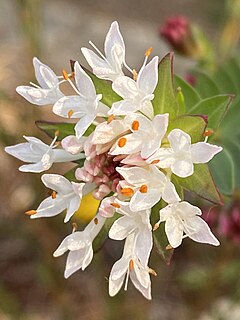
Pimelea ciliata, commonly known as white banjine, is a species of flowering plant in the family Thymelaeaceae. It is a small shrub with white flowers and is endemic to Western Australia.

Pimelea argentea, commonly known as silvery leaved pimelea, is a species of flowering plant in the family Thymelaeaceae and is endemic to the south-west of Western Australia. It is an erect shrub with densely hairy young stems and leaves, the leaves linear to elliptic, and heads of white to yellow or greenish flowers, the male and female flowers on separate plants.
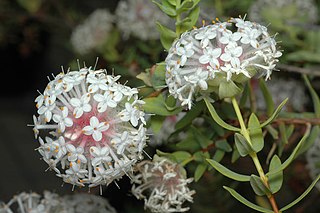
Pimelea avonensis is a species of flowering plant in the family Thymelaeaceae and is endemic to the south-west of Western Australia. It is a shrub with narrowly egg-shaped or elliptic leaves and clusters of white, tube-shaped flowers.

Pimelea bracteata, is a species of flowering plant in the family Thymelaeaceae and is endemic to the south-west of New South Wales. It is a shrub with narrowly egg-shaped to elliptic leaves and pendulous, pale green heads of pale yellow flowers.
Pimelea brevifolia is a species of flowering plant in the family Thymelaeaceae and is endemic to the south-west of Western Australia. It is an undershrub or shrub with erect, elliptic leaves, and heads of white flowers surrounded by four involucral bracts.
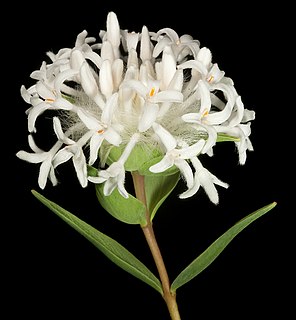
Pimelea brevistyla is a species of flowering plant in the family Thymelaeaceae and is endemic to the south-west of Western Australia. It is a shrub with narrowly egg-shaped leaves arranged in opposite pairs, and head-like racemes of white, tube-shaped flowers surrounded by yellowish involucral bracts.
Pimelea clavata is a species of flowering plant in the family Thymelaeaceae and is endemic to near-coastal areas and offshore islands of southern Western Australia. It is an erect shrub with narrowly elliptic to more or less linear leaves arranged in opposite pairs, and head-like clusters of white to pale yellow, tube-shaped flowers surrounded by leaf-like involucral bracts.
Pimelea concreta is a species of flowering plant in the family Thymelaeaceae and is native to northern Australia and parts of Indonesia. It is an annual herb with narrowly egg-shaped leaves and head-like clusters of white or pink, tube-shaped flowers surrounded by egg-shaped green involucral bracts.

Pimelea cracens is a species of flowering plant in the family Thymelaeaceae and is endemic to the southwest of Western Australia. It is an erect, spindly shrub with narrowly elliptic to egg-shaped leaves and creamy green to pale yellow flowers surrounded by 6 or 8 yellowish or pale green and reddish involucral bracts.
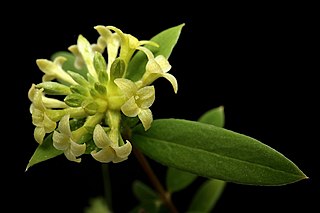
Pimelea cremnophila, commonly known as gorge rice-flower, is a species of flowering plant in the family Thymelaeaceae and is endemic to a restricted area of New South Wales. It is an erect shrub with narrowly elliptic to narrowly egg-shaped leaves arranged in opposite pairs, and groups of up to four flowers that are sometimes male-only or female-only.
Pimelea drummondii is a species of flowering plant in the family Thymelaeaceae and is endemic to near-coastal areas of southern Western Australia. It is an erect, slender shrub with narrowly elliptic or elliptic leaves arranged in opposite pairs, and white or cream-coloured flowers surrounded by 3 or 4 pairs of pale green to yellowish involucral bracts.
Pimelea eyrei is a species of flowering plant in the family Thymelaeaceae and is endemic to the southwest of Western Australia. It is an erect shrub with hairy, narrowly elliptic leaves and clusters of densely hairy, white or cream-coloured flowers.













